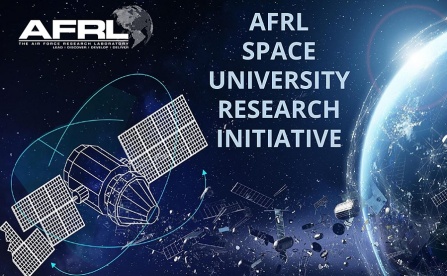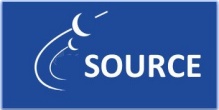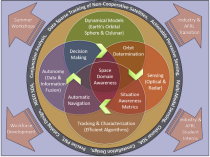About the Project
Space Object Understanding and Reconnaissance of Complex Events (SOURCE), an AFRL Space University Research Initiative.

The Need for SOURCE

Project sponsored by Air Force Office of Scientific Research (AFOSR)
Space domain awareness (SDA) describes the knowledge and real-time awareness of resident space objects (RSOs), including those man-made, like satellites, and naturally occurring, like meteoroids. Although the U.S. must overcome many technological challenges to achieve SDA dominance in the geostationary (GEO) region, challenges increase dramatically when considering expansion beyond GEO (XGEO), to include cislunar activities.
XGEO is one-thousand times the volume of GEO. The scope of the cislunar space contains the Earth, moon and Lagrange points where satellites may perform many future functions.
According to former Space Development Agency director Fred Kennedy, the U.S. needs “to rapidly develop responses to threats that we can anticipate now, [threats] that could take existing organizations years or maybe decades to acquire a custom solution for.”
AFRL's Col. Eric Felt states, “If you look at the orbits of the stuff that's going around the moon, it looks like a drunken sailor wandering around as compared to the orbits that we're used to describing closer to the Earth," which underscores a significant challenge related to many key aspects of SDA.
Our Approach
The Space Object Understanding and Reconnaissance of Complex Events (SOURCE) team’s approach is to significantly expand the research envelope to include developing new theoretical approaches leading to useful algorithms, and investigating new sensor concepts with meaningful data and information fusion to provide a revolutionary SDA capability to overcome both XGEO challenges and future SDA challenges within the GEO belt.
The project's principal investigator is John Crassidis, director of the Collaborative Institute for Multisource Information Fusion (CIMIF), and SUNY Distinguished Professor at the University at Buffalo. Moises Sudit, executive director of CIMIF and a professor in the Department of Industrial and Systems Engineering, is co-principal investigator. The deputy investigator is Puneet Singla, a professor at Penn State University.
The project’s multidisciplinary team of investigators includes renowned researchers from the University at Buffalo, the Massachusetts Institute of Technology, Penn State University, Georgia Tech and Purdue University. The team combines experts in cislunar astrodynamics, multi-modal sensing architectures, advanced data association algorithms, position and orientation estimation techniques, uncertainty quantification, RSO attribute estimation through characterization, dynamic sensing, catalog design and autonomous decision-making element.










